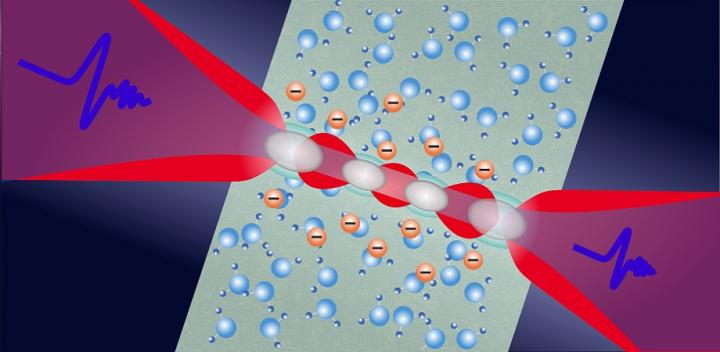THz spectroscopy tracks electron solvation in photoionized water

THz spectroscopy probes photoexcited plasma in water, from Tan et al., doi 10.1117/1.AP.3.1.015002
Credit: Tan et al., doi 10.1117/1.AP.3.1.015002
THz wave absorption signal with a unique two-step decay characteristic in the time domain was demonstrated, revealing fundamental aspects of the charge transport process in water.
Photoionization of water involves the migration and solvation of electrons, with many transient and highly active intermediates. The process results in a large blue shift in the absorption spectrum, from the THz or gigahertz region to the visible range. While the behavior of low-density quasifree electrons excited by small pump power density has been investigated extensively, we still know little about the transient evolution of photoexcited plasma in liquid water. Valuable insights were recently provided by an international research team in a study published in Advanced Photonics.
According to Liangliang Zhang, physics professor at Capital Normal University in Beijing and one of the senior authors on the study, the physical mechanism of plasma evolution on the ultrafast sub-picosecond scale in liquid water is considered as an extension of the theory of gas plasma. But laser-induced plasma in liquid water is accompanied by more complex and stronger nonlinear effects than those in gas, since water has a higher nonlinear coefficient, a lower excitation threshold, and a higher electron density. These differences promise the possibility of unlocking new technologies and applications, encouraging researchers to explore the potential physical mechanism of photoexcited plasma in liquid water.
Water solvent electrons?
Zhang’s team induced plasma in a stable free-flowing water film by using 1650-nm femtosecond laser pulses. They focused these intense terahertz (THz) pulses to probe at the sub-picosecond scale the temporal evolution of quasifree electrons of laser-induced plasma in water. THz wave absorption with a unique two-step decay characteristic in the time domain signature was demonstrated, indicating the significance of electron solvation in water.
Using the Drude model combined with the multilevel intermediate model and particle-in-a-box model, the researchers simulated and analyzed the quasifree electrons to obtain key information such as the frequency-domain absorption characteristics and solvation ratio. Remarkably, as the quasifree electron density increased, the traps related to the bound states appeared to saturate, resulting in a large number of quasifree electrons that cannot be completely solvated. According to Zhang, “This work provides insights on the fundamental aspects of the charge transport process in water and lays a foundation for further understanding of the physicochemical properties and transient evolution of femtosecond-laser-pulse-excited plasma in water.”
###
Read the original research article by Yong Tan et al., “Transient evolution of quasi-free electrons of plasma in liquid water revealed by optical-pump terahertz-probe spectroscopy,” Adv. Photon. 3(1), 015002 (2021), doi 10.1117/1.AP.3.1.015002
All latest news from the category: Physics and Astronomy
This area deals with the fundamental laws and building blocks of nature and how they interact, the properties and the behavior of matter, and research into space and time and their structures.
innovations-report provides in-depth reports and articles on subjects such as astrophysics, laser technologies, nuclear, quantum, particle and solid-state physics, nanotechnologies, planetary research and findings (Mars, Venus) and developments related to the Hubble Telescope.
Newest articles

Innovative 3D printed scaffolds offer new hope for bone healing
Researchers at the Institute for Bioengineering of Catalonia have developed novel 3D printed PLA-CaP scaffolds that promote blood vessel formation, ensuring better healing and regeneration of bone tissue. Bone is…

The surprising role of gut infection in Alzheimer’s disease
ASU- and Banner Alzheimer’s Institute-led study implicates link between a common virus and the disease, which travels from the gut to the brain and may be a target for antiviral…

Molecular gardening: New enzymes discovered for protein modification pruning
How deubiquitinases USP53 and USP54 cleave long polyubiquitin chains and how the former is linked to liver disease in children. Deubiquitinases (DUBs) are enzymes used by cells to trim protein…


